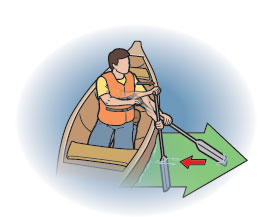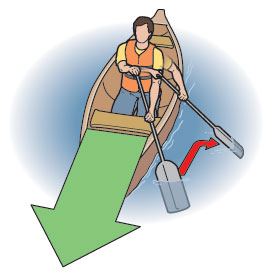Different Strokes for Canoeing Folks
By Karen Berger
Illustrations by Topdog Illustration
Once you've mastered these five basic canoeing maneuvers, you'll be able to navigate flat-water lakes and gently flowing rivers.
Paddling a canoe has a gentle learning curve: The basic strokes aren’t difficult, but knowing them will make the experience go more smoothly—including your return to shore at the end of a long day.
In most instances, bow (front) and stern (rear) canoe partners should always paddle on opposite sides of the boat. If you’re paddling on the right side, place your left hand on top of the paddle (grip hand); the right hand holds the shaft (shaft hand). To paddle on the other side, switch hand positions so that the right hand holds the paddle grip and the left hand is on the shaft.
On flat water, the most comfortable position in the boat is to sit. However, in fast-moving water or rapids, canoeists should kneel in their boats (on a cushion of some sort) to lower their center of gravity and increase the canoe’s stability.
While one person can paddle a canoe solo, canoeing is much easier with two. Two paddlers create more propulsion and don’t have to compensate for the fact that paddling on one side only causes the canoe to turn. The stronger paddler should sit in the stern.
 The Draw Stroke
The Draw Stroke
Sometimes called the “pull-to,” the draw stroke is used to change the direction of the canoe. It can also be used to move the canoe sideways, such as when you’re pulling alongside a dock. Reach out as far as possible with the shaft hand and place the paddle into the water. Then push your gripping hand outward while pulling your shaft hand inward; this creates leverage and moves the canoe in the direction of your paddling side.
 The Pry Stroke
The Pry Stroke
This is the opposite of the draw stroke. It’s used to push the canoe away from the paddling side. Place the blade in the water parallel to the boat; it should be as close to the canoe as possible, even tilted a bit so it’s almost underneath the boat. Your gripping hand should be out over the water as far as you can reach. Pull in with the grip hand while pushing out with the shaft hand.
 The J-Stroke
The J-Stroke
This is a forward stroke with a hook on the end. It is most often used by solo paddlers and by stern paddlers who are stronger than their partners. Its purpose is to compensate for the canoe’s tendency to turn during the simple forward stroke. It does not replace the forward stroke but instead supplements it when necessary. The J-stroke is so-named because it traces a letter “J” in the water when done on the port (left) side of the boat. Begin as you would for a forward stroke, but when the paddle blade crosses to the back of your body, twist the shaft so that the blade turns outward. On the port side, this means turning the blade clockwise. Reverse the motion for paddling on the starboard (right) side.
 The Forward Stroke
The Forward Stroke
Reach forward with both the shaft and grip hands and place the paddle in the water. Then simply draw it straight back with the face of the blade perpendicular to the water, twisting your torso through the stroke. When you withdraw the paddle from the water for the next stroke, “feather” it (swinging the blade forward, flat above the water’s surface) to reduce wind resistance. When equally matched, the bow and stern paddlers can act in rhythm with each other, each staying on opposite sides of the canoe until tired. Then switch sides.
 The Back Stroke
The Back Stroke
This is the reverse of the forward stroke. Simply reach back with both hands and place the paddle in the water to the rear of your body. Then pull forward, with the flat side of the blade perpendicular to the canoe. Feather the blade as you reach back for another stroke. The backward stroke is used to stop the canoe when you already have forward momentum or slow it in moving water. If used by the bow paddler on one side of the boat while the stern paddler uses the forward stroke on the other side, it can be used to pivot the boat.
Karen Berger is the author of Backpacking and Hiking (BSA No. 34354, $20). Visit her Web site at www.hikerwriter.com.